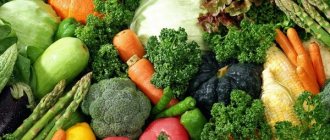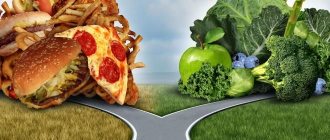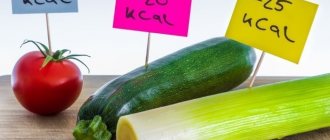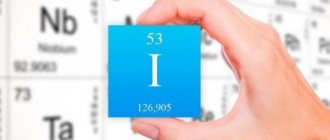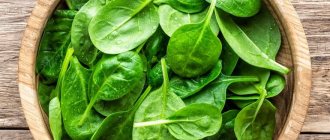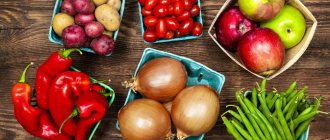Slow glucose (low GI) is beneficial. Eat these carbohydrates every day, even on the most restrictive diet. Forget about counting calories! Allow yourself “healthy” foods without regard to calorie content.
The energy for the activity and vitality of a healthy person’s body always comes from food. Most of the energy needs are met by foods rich in carbohydrates. Carbohydrates are traditionally divided into fast and slow. They are also called simple and complex (or complex). Weight loss occurs if you exclude a maximum of simple “bad” carbohydrates from your diet, leaving “good” carbohydrates on the menu.
Fats, proteins and carbohydrates - what goes with what
Nutritionists have long divided all the products on the human dining table into three general groups:
- Protein food
- Fats
- Carbohydrates
The first includes meat and fish in any form, eggs of all types of birds, legumes, and various nuts. The most powerful and at the same time dangerous source of energy in terms of calorie content are heavy animal fats and vegetable-based oils (including refined ones). Fat enters the body with fish and dairy products, meat and eggs. Finally, carbohydrate-containing products are all types of flour products, sugar and all variety of sweets, potatoes, and cereals. Carbohydrates are in no way compatible with proteins and vice versa.
The main difference between the former and the latter is that for proper digestion of a protein product in the stomach and its high-quality breakdown, the gastrointestinal tract must have an acidic environment, and in order for carbohydrate-type food to be properly absorbed by the body, the environment in the stomach must become alkaline. Thus, when these incompatible food groups are combined on your plate, your stomach will either ignore the first when digesting it, or will not digest the second. This threatens regular digestive disorders, disruptions in the gastrointestinal tract, decreased metabolic rate, diabetes mellitus and negative weight fluctuations.
But the third group - fats - is compatible with both the first and second, but is categorically not recommended for a person losing weight. True, only in some of its product variations. Despite the persistent associations of fatty foods with French fries and hamburgers and, as a result, with extra pounds and blurred waistlines, the “right” fat (which is unsaturated fatty acids) is able to burn out the most hopeless fat deposits from the body. Healthy sources of unsaturated fats include: avocado, fish and white meat, nuts and natural vegetable oils (first and second pressing).
Main types of carbohydrates
Depending on the amount of saccharides - those building blocks that make up the molecules, all carbohydrates are divided into simple (aka monosaccharides) and complex (polysaccharides).
The first group includes:
- Glucose
(other names: grape sugar, dextrose) - found in berries, fruits, honey. This is the end product of the breakdown of complex carbohydrates in the body.
Here, perhaps, lies the main truth: whether we eat a banana or a potato, we will ultimately get the same substrate at the output. The difference lies only in the rate of secretion and the amount of insulin secreted by the pancreas - we’ll talk about this in more detail below.
Glucose, in addition, easily undergoes fermentation, the constant companions of which are bloating, rumbling and flatulence, which usually cause considerable discomfort.
- Fructose
(levulose or fruit sugar) is a widely used sweetener in nature, which is 2.5 times sweeter than glucose - an undeniable advantage for confectionery manufacturers. It is a structural component of sucrose.
- Galactose
- Contains lactose (milk sugar).
Disaccharides can be distinguished as a separate group
(consist of two monomers).
The most famous among them:
- Sucrose
(sucrose, cane sugar) is one of the most common disaccharides in nature (consists of glucose and fructose molecules). Its highest concentration is in beets and cane, which are used industrially for the production of table sugar.
- Lactose
- found in dairy products. Its molecule includes one glucose and one galactose residue. It is used as a nutrient medium for the growth of bacteria, as well as for the production of drugs used in the treatment of various intestinal disorders.
- Maltose
- malt sugar, consisting of two glucose residues. Contained, as a rule, in grain crops.
The second group includes polysaccharides
- large, branched carbohydrate chains, which contain hundreds and thousands of sequences of simple sugars:
- Starch
- a reserve substance of plants, concentrated in grain crops and potatoes.
- Cellulose
- the main component of the cell wall of higher plants and algae. Helps move food through the intestines, stimulating peristalsis.
- Glycogen
- the main reserve pool of carbohydrates that fills the pantries of the liver and skeletal muscles.
- Pectin
- present in the intercellular space of all higher plants. It has mild sorption and chelator properties.
We should also talk about dietary fiber
.
Fiber
is a collection of various plant substances that are not digested in the small intestine of humans and many animals: digestive enzymes are not able to hydrolyze (decompose) them into monomer bricks. Our body's resident bacteria ferment them, and the metabolites released in the large intestine are used by both the host organism and the microflora inhabiting it.
Fiber includes cellulose, pectin, resins, and lignin - these components have a unique chemical structure that gives them properties such as viscosity, volume, binding or adsorption, and water-holding capacity. It is practically incapable of fermentation and has a pronounced laxative effect.
We recommend
“Fiber-rich foods: benefits for the body” Read more
Dietary fiber causes a feeling of fullness and satiety - this is due to their bulking ability (imagine cotton wool swollen with moisture, which has increased many times in size).
When they are hydrated, viscous compounds (colloidal dispersions) are also formed, which have a beneficial effect on gastric emptying (evacuation of food), as well as the absorption of fats and carbohydrates.
In addition, fiber affects the texture of the product - foods rich in fiber increase the time required to chew and the associated energy costs.
Sources of fiber include fruits and vegetables, grain products, nuts and legumes.
Recommended amount: from 25 grams
in a day.
Research
: Dietary fiber: concept, classification and current indications, Carbohydrates and fiber, Dietary Fiber and Energy Regulation
Dividing carbohydrates into “bad” and “good” is as incorrect as dividing hormones into male and female: both groups are necessary for the normal functioning of our body.
In nutrition and medicine, there is a classification already described: simple sugars and complex ones.
Complex carbohydrates (also known as polysaccharides) during cavity or parietal (directly on the intestinal villi) digestion are decomposed into their component “building blocks” - monosaccharides. This is how they are absorbed.
Their features, such as a low glycemic index, the absence of sharp jumps in insulin, slowing down the movement of the food bolus and, consequently, increasing the time of action of digestive juice enzymes, distinguish them from simple sugars.
To build a healthy, balanced diet that will keep you productive throughout the day, consider the following foods:
- Whole wheat bread.
- Brown rice.
- Buckwheat grain.
- Quinoa.
- Corn.
- Lentils, beans, peas.
However, it should also be noted that cereals, legumes and oilseeds contain phytic acid - this is a natural plant defense mechanism. This antinutrient, entering the gastrointestinal tract, impairs the absorption of iron, calcium, magnesium, phosphorus and zinc - vital minerals. It is also associated with the development of irritable bowel syndrome and various food sensitivities. This is why soaking cereals before their direct consumption is so important - for partial deactivation of phytic acid.
In addition, rinsing rice grains before cooking can remove 3 to 43% of arsenic. The fact is that rice is grown as a lowland crop in flooded fields: under these conditions, the bioavailability of this highly toxic substance only increases, leading to its excessive accumulation.
Study
: Realistic risk assessment of arsenic in rice
But simple carbohydrates are not equally harmful: after all, the same glucose, in addition to its energy function, performs a number of other, no less important ones (for example, in the process of its metabolism it is accompanied by the production of raw materials for the formation of nucleic acids - DNA and RNA).
What are bad and good carbohydrates
Carbohydrates are organic compounds of carbon and water. The human body will not function fully without regular carbohydrate feeding. Without the intake of carbohydrates, the internal organs will not be able to process either fats or proteins and the liver, the most important organ for enriching blood cells with the necessary substances, will cease to function properly.
Carbohydrates are the main supplier of food for the mind - glucose for the brain.
The division into slow/fast carbohydrates is directly related to the speed of their breakdown by the body and the time of transformation into nutritious glucose. By the way, glucose is precisely the main irreplaceable energy source for the body.
To measure the speed of a car, the mileage traveled is used, divided by the time unit hour - kilometers per hour. To indicate the rate of breakdown of glucose, an equally interesting measurement value has been introduced - the glycemic index.
Glycogenosis and other disorders
But in some cases, glycogen breakdown does not occur. As a result, glycogen accumulates in the cells of all organs and tissues. Typically, such a disorder is observed in people with genetic disorders (dysfunction of the enzymes necessary to break down the substance). This condition is called glycogenosis and is included in the list of autosomal recessive pathologies. Today, 12 types of this disease are known in medicine, but so far only half of them have been sufficiently studied.
But this is not the only pathology associated with animal starch. Glycogen diseases also include aglycogenosis, a disorder accompanied by a complete absence of the enzyme responsible for glycogen synthesis. Symptoms of the disease are pronounced hypoglycemia and convulsions. The presence of aglycogenosis is determined by liver biopsy.
List of foods with healthy carbohydrates (and glycemic index below 40):
- brown and colored long rice
- unprocessed rice
- wholemeal bread products
- whole wheat noodles
- all types of cereals, with the exception of semolina
- fresh or frozen zucchini
- green spinach and other greens from the garden
- all types of cabbage
- sour fruits (fresh kiwi and grapefruit, orange, and green apple)
- boiled red and green lentils
- all types of soybeans
- beans, beans
- barley porridge
- dried apricots
- plums with peaches
- ripe avocados
- fresh bell and chili peppers
- onions of all types - yellow, red, leek and others
- processed edible mushrooms
- juicy fresh tomatoes
The benefits and harms of carbohydrates
Some of the beneficial properties of carbohydrates include:
- generating energy for mental and physical activity;
- satiation of the body and suppression of hunger;
- regulation of metabolism;
- reduction of cholesterol in the blood and pain during menstruation;
- production of the hormone of joy;
- protection against diseases of the cardiovascular system and gastrointestinal tract.
Despite all the benefits, excessive consumption of carbohydrates can lead to obesity and other diseases stemming from the underlying cause. The fact is that excess carbohydrates with reduced activity turn into fat reserves. In this regard, you should treat your diet responsibly and not exceed existing standards.
How “proper” carbohydrates work
Once in the body with food, they are absorbed into the walls of the gastrointestinal tract and slowly raise blood sugar levels. There are no glucose surges in the body, the person’s mood and condition remain stable and even. In general, don’t want to be considered a nervous and fussy person? Adjust your diet towards the healthiest “slow” carbohydrates.
It is noteworthy that a person starts digesting this type of carbohydrate from the first piece of product that enters the mouth. This is facilitated by a special enzyme produced by human saliva. Therefore, no to stress, yes to weight loss and peace!
Why does the body need fast carbohydrates?
Research shows that sugars make it possible to digest foods rich in proteins and fats. All doctors and nutritionists are of the same opinion that the diet should mostly consist of foods with slow carbohydrates.
However, there are situations when it is necessary to quickly restore energy, even for a short time, in which case fast carbohydrates are irreplaceable. They sharply increase blood glucose levels, which leads to a surge in insulin, intense blood circulation, and high muscle tone. This helps to cope with lightheadedness, dizziness, and nausea.
In addition, fast carbohydrates:
- help cope with mental tasks by activating brain function;
- replenish glycogen reserves in the body;
- neutralize toxins;
- participate in the construction of the cell frame;
- help fight stress and relieve depression;
- control metabolism by activating the synthesis of various hormones and enzymes in the body.
If a person regularly visits the gym and exercises intensively, then fast carbohydrates in small quantities help reduce excess weight by accelerating the burning of fat deposits.
In the absence of proper physical activity, jumps in glucose levels only replenish fat deposits in the body and harm the functioning of the pancreas, muscles and cardiovascular system. A person needs to consume up to 40 g of fast sugars per day and only in the first half of the day.
"Wrong" carbohydrates
As it becomes clear from the explanation of the effectiveness of carbohydrates with an eye to the speed of their absorption, fast carbohydrates (or “death to the diet”) are those that have a high glycemic index. They, of course, are also saturated with a number of vitamins, and they contain microelements. But they have much less benefit than low-index carbohydrates. Therefore, it is not recommended for those who want to lose weight to allow themselves to do so every day. By the way, this type of carbohydrate includes alcohol, which is unloved by nutritionists, in all its variations.
But if you can’t do without “wrong” carbohydrates, then allow yourself delicious desserts, delicious pastries, relaxation with a glass, at least in the format of a very rare “holiday”. Remember, more frequent concessions to your “I want and I will” do more damage not to your waist width, but to your health in general. Thus, the pancreas, which is responsible for the production and supply of insulin, begins to work at the limit of its capabilities as soon as the body is overloaded with such “wrong” carbohydrate foods. As a result, blood sugar jumps, the mood changes from cheerful to tearful, the brain plunges into despondency, and the stressful state and gloomy tension do not go away even after “treatment” with chocolate-covered buns.
Stimulation by serotonin (the hormone of happiness) from the consumption of carbohydrate foods can be avoided to the point of absurdity if you heed the advice of doctors. Cheer yourself up (occasionally) with the following foods.
Daily carbohydrate needs
Adherents of proper nutrition are advised to know the daily carbohydrate intake in order to correctly calculate their diet. Nutritionists advise using the formula: 5 grams of the element per 1 kilogram of your weight for a sedentary lifestyle or weight loss, or 8 grams per 1 kilogram of your weight for an active lifestyle.
To calculate your individual micronutrient requirements, you should know several rules:
- if you exercise regularly, the most carbohydrates should be consumed within 2-3 hours after completion of training, during the opening of the “carbohydrate window”;
- people who are not keen on sports should divide the intake of the element evenly throughout the day;
- Do not get carried away with foods containing excessive amounts of carbohydrates, as their excess can be fraught with problems with the gastrointestinal tract.
The daily norm of any element is calculated individually, based on the characteristics of the person:
- height and weight parameters;
- age;
- health indicators;
- test results;
- speed of metabolic processes;
- individual characteristics.
Table of average carbohydrate consumption per day
| Daily physical activity level | Age | For women, g | For men, g |
| Short | 18-30 | 323 | 330 |
| 30-45 | 310 | 320 | |
| 45-60 | 295 | 305 | |
| Moderate | 18-30 | 350 | 365 |
| 30-45 | 335 | 340 | |
| 45-60 | 320 | 330 | |
| Average | 18-30 | 370 | 385 |
| 30-45 | 360 | 375 | |
| 45-60 | 340 | 350 | |
| High | 18-30 | 440 | 455 |
| 30-45 | 420 | 430 | |
| 45-60 | 400 | 405 | |
| Sports | 18-30 | 450 | 450 |
| 30-45 | 435 | 440 | |
| 45-60 | 430 | 435 |
List of foods with a glycemic index above 60:
- honey, propolis, bee waste products
- fresh and canned candied pineapples
- dried raisins
- watermelon
- Yellow banana
- sugar melon
- sweet dates
- pancakes, including store-bought ones
- crackers
- sweet corn flour sticks
- corn flakes, including for children
- instant porridge (oatmeal, etc.)
- potatoes baked in the oven or in the coals of a fire
- homemade/instant potato puree
- boiled carrots
- turnip
- all types of pumpkin fruits and desserts
- white rice
- grain and white bread
- cookies
- couscous, including coarse wheat flour
- semolina
- dry prepared food products (industrial production adds pure carbohydrates - sugar/glucose, as well as starch) to already processed products.
Carbohydrate-rich foods
Looking at photos of products with a large amount of carbohydrates, it is impossible not to feel an appetite, and, forgetting about calorie content, under the pretext that the body not only needs energy, but also urgently needs it, to eat sweets and delicacies that are unnecessary for the figure.
But when setting your table with carbohydrate foods, do not forget about the diet and that everything is good in moderation, the menu should be balanced.
A large amount of carbohydrates contain:
- butter cookies, pies made from wheat flour, white bread;
- confectionery products;
- sweet soda, juices;
- a variety of cereals and cereal flakes;
- potato dishes;
- mayonnaise sauces;
- honey;
- fruits;
- milk, sour cream, cottage cheese;
- sunflower seeds and nuts.
Low carbohydrate foods:
1 g of carbohydrates contains, on average, 4.1 kcal, therefore, the least of them is in products with low energy value:
- in greenery;
- in vegetables containing a small amount of starch (for example, there is a lot of starch in potatoes and boiled beets and carrots);
- in eggs;
- in soft cheeses, pickled cheese.
How to lose weight with carbohydrates, proteins, fats
Knowledge is power, and separate nutrition is power, assure crowds of men and women who have achieved ideal indicators on the scales thanks to the separate nutrition system. The main advantage of separate nutrition is the absence of strict prohibitions, and therefore, breakdowns. The creator of the system is Dr. Herbert Shelton, famous in the twentieth century.
So, the rules of separate nutrition (or carbohydrate-protein diet):
- Never eat proteins with carbohydrates. The latter should be put into the mouth no earlier than three to four hours after eating protein food.
- A carbohydrate food is one that contains at least 20% carbohydrates. A protein product is one that contains more than 10% protein.
- One meal should contain only 3-4 foods, either protein or carbohydrate. Are you planning to have a healthy vegetable salad for lunch? And it should be prepared with no more than 2-3 ingredients!
- Planning a protein lunch or dinner? Supplement it with a freshly chopped vegetable salad without starch (for example, Chinese cabbage, fresh cucumber, juicy radish, red-sided tomato).
- Avoid combining carbohydrate foods with a GI above 60 with foods containing acids (lemon, apple, grapefruit, tomato).
- Acidic foods are also incompatible with raisins (cottage cheese, fish, etc.).
- If giving up sugar is very difficult, replace it with bee products. Don’t be cunning and buy food with “unnoticeable” sugars.
- No mono diet! No monotonous diet, otherwise there is a high risk of serious harm to your health. On one day, alternate meals as much as possible in different meals.
- Do you want some bread? Eat! But not as a snack to chicken broth or vegetable salad, but as a separate independent product - an autonomous meal.
- For pregnant women, any food experiments and diets are completely prohibited. Restrictions on food and adjustments to the diet of an expectant or nursing mother should occur under the strict supervision of a supervising physician.
What foods contain carbohydrates
The table of carbohydrates will make it possible to understand how much of the substance the foods a person eats contain.
Carbohydrate-rich foods
| Product name | Mass fraction of carbohydrates (in grams) per 100 grams of product |
| Granulated sugar | 99 |
| Caramel, candy candies | 96 |
| Honey | 81 |
| Pastila, marshmallow | 81 |
| Marmalade | 79 |
| Gingerbread | 74 |
| Cookie | 69-74 |
| Strawberry jam | 74 |
| Rice flour | 80 |
| Rice groats | 74 |
| Corn flour | 72 |
| Corn grits | 71 |
| Drying bagels | 71 |
| Semolina | 70 |
| Buckwheat flour | 70 |
| Wheat flour | 65-70 |
| Pasta | 68-70 |
| Raspberry jam | 70 |
| Dates | 70 |
| Wheat groats | 68 |
| Pearl barley | 67 |
| Millet | 66 |
| Crackers | 67 |
| Rye flour | 62-66 |
| Oat bran | 66 |
| Raisin | 66 |
| Barley groats | 65 |
| Oatmeal | 65 |
| Cake | 49-63 |
| Waffles | 62 |
| Rice | 62 |
| Hercules | 62 |
| Buckwheat | 57-60 |
| Chocolate candies | 60 |
| wheat grain | 57-59 |
| Dried pears | 62 |
| Dried apples | 59 |
| Dried figs | 58 |
| Dried peach | 58 |
| Prunes | 57 |
| Condensed milk | 55-57 |
| Barley grain | 56 |
| Rye grain | 56 |
| Oat grain | 55 |
| Butter buns | 55 |
| Halva | 54 |
| Dried apricots | 53 |
| Dried apricots | 51 |
| loaf | 51 |
| Milk chocolate | 50 |
| bitter chocolate | 48 |
| Bread | 33-49 |
| Peas | 48 |
| Beans | 47 |
| Lentils, chickpeas, mung bean | 46 |
| Powdered milk | 39-50 |
| Alcoholic drinks | 20-35 |
| Cheesecakes in chocolate glaze | 32 |
| Pancakes | 31 |
| Garlic | 30 |
| Pistachios | 27 |
| Fried potatoes | 23 |
| Cashew | 22 |
| Rose hip | 22 |
| Bananas | 21 |
| Ice cream | 19-20 |
| Sweet corn | 19 |
| Syrniki | 18 |
| Ginger | 18 |
| Soybeans | 17 |
| Wheat bran | 16 |
| Peach, grape juice | 16 |
| Grapes, persimmon, mango, feijoa | 15 |
| Porridge | 15-20 |
Foods containing carbohydrates
Dairy
| Product name | Mass fraction of carbohydrates (in grams) per 100 grams of product |
| Acidophilus | 4 |
| Varenets | 4 |
| Yogurt | 8-14 |
| Kefir | 4 |
| Kumis | 5-6 |
| Milk | 5 |
| Buttermilk | 5 |
| Curdled milk | 4 |
| Ryazhenka | 4 |
| Cream | 4 |
| Sour cream | 3-4 |
| Cottage cheese | 3 |
| Adyghe cheese | 2 |
| Parmesan cheese | 1 |
| Sulguni cheese | 0.5 |
| Chees Feta | 4 |
| Gouda cheese | 2 |
| Processed cheese | 2-4 |
| Butter | 1 |
Nuts, seeds
| Product | Carbohydrate content (in grams) per 100 grams of product |
| Peanut | 10 |
| Walnut | 11 |
| Cedar nut | 13 |
| Cashew | 23 |
| Almond | 13 |
| Pistachios | 27 |
| Hazelnut | 9 |
| Sunflower | 10 |
| Sesame | 12 |
Fruits vegetables
| Product | Carbohydrate content (in grams) per 100 grams of product |
| Quince | 10 |
| Apricot | 9 |
| Cherry plum | 8 |
| A pineapple | 11 |
| Avocado | 2 |
| Orange | 8 |
| Watermelon | 6 |
| Eggplant | 5 |
| Banana | 21 |
| Cowberry | 8 |
| Swede | 8 |
| Basil | 3 |
| Grape | 15 |
| Cherry | 11 |
| Blueberry | 7 |
| Pomegranate | 14 |
| Pear | 10 |
| Grapefruit | 7 |
| Melon | 7 |
| Blackberry | 4 |
| Strawberries | 8 |
| Fresh figs | 12 |
| Zucchini | 5 |
| White cabbage | 5 |
| Broccoli | 7 |
| Brussels sprouts | 3 |
| Kohlrabi cabbage | 8 |
| Red cabbage | 5 |
| Cabbage | 2 |
| Savoy cabbage | 6 |
| Cauliflower | 4 |
| Potato | 16 |
| Kiwi | 8 |
| Cilantro | 4 |
| Cranberry | 4 |
| Watercress | 6 |
| Gooseberry | 9 |
| Lemon | 3 |
| Green onions | 3 |
| Onion | 8 |
| Leek | 6 |
| Raspberries | 8 |
| Mango | 15 |
| Mandarin | 8 |
| Carrot | 7 |
| Cloudberry | 7 |
| Sea kale | 3 |
| Nectarine | 11 |
| Sea buckthorn | 6 |
| Cucumber | 3 |
| Papaya | 11 |
| Parsnip root | 9 |
| bell pepper | 5 |
| Peach | 10 |
| Parsley | 8 |
| Pomelo | 10 |
| Tomatoes | 4 |
| Rhubarb | 3 |
| Radish | 3 |
| Radish | 7 |
| Turnip | 6 |
| Red rowan | 9 |
| Chokeberry | 11 |
| Salad | 2 |
| Beet | 9 |
| Celery greens | 2 |
| Celery root | 7 |
| Plum | 10 |
| Currant | 7-8 |
| Asparagus | 3 |
| Jerusalem artichoke | 13 |
| Pumpkin | 4 |
| Dill | 6 |
| Horseradish | 11 |
| Persimmon | 15 |
| Cherries | 11 |
| Blueberry | 8 |
| Garlic | 30 |
| Rose hip | 22 |
| Spinach | 2 |
| Sorrel | 3 |
| Apples | 10 |
Common truths of losing weight
- Eliminate any sugars from your diet.
- Forget about flour and baked goods made from premium flour.
- Throw all purchased processed foods in the trash.
- There is no need for energy bars for athletes; they are easily replaced with natural “correct” carbohydrate products.
- Monitor your blood insulin levels. Its low level starts the fat burning process.
- Carbohydrates - for breakfast, for energy, activity, sports.
- If you have a choice between proteins or carbohydrates for dinner, take proteins (fish, cottage cheese, eggs). This way, insulin will remain at its previous level (there are no sweets on the dinner menu), and the weight loss process will continue even in your sleep!
It is noteworthy that during separate meals you will not have to try to overcome the constant feeling of hunger. You will eat quite normally and eat as much as you need to feel full. You will not experience mood swings, the desire to take a nap, irritability and fatigue.
Without sacrifices, financial costs, psychological breakdowns, and most importantly - practically without effort, you will begin to lose weight and become more active and cheerful!
3 dinners for two with free delivery for RUB 1,990.
View menu
Table of carbohydrate content in food
| Name | Amount of element per 100 grams of product |
| Legumes | 2-63 gr |
| Cereals and grains | 3-73 gr |
| Fruits and dried fruits | 5-88 g |
| Vegetables | 5-80 gr |
| Milk products | 2-54.5 g |
| Fish and seafood | 1.5-11.5 g |
| Meat | 0.1-5 g |
You don't need to know everything about carbohydrates to get the most out of an element.
It is enough to understand the individual characteristics of your body, be aware of its needs, navigate the composition of food products and eat a balanced diet.
Products that do not contain carbohydrates
If you decide to seriously take care of your figure and cut down on carbohydrates, then please note that finding products without a carbohydrate component is not so easy.
The basis of a low-carbohydrate diet is protein foods. All fresh meat products should not contain carbohydrates. However, they undergo some changes when they hit supermarket shelves. To improve the taste, manufacturers add salt, spices and sugars, which change the final calorie content of the product.
0% carbohydrates are also found in natural coffee and tea without added sweetener. If you are tormented by hunger, the diet does not allow you to waste calories, and the next meal is not soon - prepare one of these drinks.
What carbohydrates are healthy?
Healthy carbohydrates have a complex chemical structure that is difficult to digest under the influence of active digestive enzymes and hydrochloric acid. As a result, nutrients are absorbed slowly, but by 90-100%. For a long time, while food passes through the gastrointestinal tract, the body spends the resulting carbohydrates as energy for the functioning of internal organs and systems.
With the rapid absorption of simple carbohydrates, tissues cannot process the resulting saccharides, so excess nutrients begin to transform the liver into adipose tissue.
Cereals and legumes have a high content of complex carbohydrate chains. The body can obtain the maximum amount of vitamin and mineral compounds after digesting the germs and shells of grains. It is important to remember that under the influence of thermal and chemical treatment, 80% of the nutritional components are destroyed. Porridges should be steamed or cooked in water to reduce their calorie content.
High Carbohydrate Diet for Weight Loss
This weight loss technique is based on reducing the total calorie intake of the diet. To do this, you will need to exclude foods containing fast carbohydrates from the menu. They should be replaced with foods with complex carbohydrate chains. Therefore, your list of foods for weight loss should include foods rich in plant fiber. The dietary fiber found in fruits and vegetables causes a feeling of false satiety.
When it enters the stomach, fiber begins to swell, filling the free space. As a result, hunger is dulled, the daily amount of food consumed is reduced, as is the serving size. The chemical compound is practically not digested, so the body spends more energy on digestion than it receives from plant foods.
In addition to fresh vegetables and fruits, you should eat cereal porridges cooked in water. They have a similar effect, reducing appetite for 3-4 hours.
Diet to increase muscle mass
To gain lean muscle mass, you should follow a high-protein, low-carbohydrate diet. In order to obtain fructose and glucose, it is necessary to consume vegetables, fruits and leafy greens, with the exception of:
- bananas;
- grapes;
- potatoes;
- corn;
- various cereals
To prevent glucose from being converted into glycogen in the liver, you should drink up to 2 liters of liquid per day. It is allowed to consume freshly squeezed fruit, berry, and vegetable juices, herbal decoctions and still mineral water. Drinks will help remove excess fluid from the body and cause the breakdown of fat masses.
Carbohydrate intake rate
The norms for carbohydrate intake for any person should be approximately half of the total calories. Carbohydrates are the main resource for replenishing energy. Accordingly, the remaining 50% is distributed between proteins and fats. The average person needs about 300 grams of carbohydrates per day, of which 200-250 grams are complex carbohydrates and fiber, and approximately 25 grams are fructose and sucrose.
Athletes sometimes require more protein and carbohydrates than a person whose physical activity is not as high. With low physical activity, a person needs about 3-5 g of carbohydrates per kg of weight, which can be increased to 7 or even 10 grams per kg of weight with intense training and heavy physical work.
What role do carbohydrates play in the body?
Carbohydrate foods are necessary to compensate for the body's internal energy costs. Organic compounds, if necessary, provide a set of muscle and fat mass. Carbohydrates that enter the body along with the food consumed have the following properties:
- Participate in the formation of various soft tissue structures. Polysaccharide chains are necessary to create and strengthen the outer cell membrane. Carbohydrates supply energy to cell nuclei, ensuring normal chromosome division. Organic compounds are necessary for the creation of nucleic acids, the production of active enzymes and neurotransmitters.
- They supply energy resources to the body. After food enters the stomach, nutrients are split off from the general chemical structure and descend into the intestinal tract. Microvilli absorb carbohydrates into the blood. Organic substances enter the intracellular space through the vascular bed, where they undergo oxidative reactions. As a result, 1 g of carbohydrates produces 17 kJ of energy. The oxidation process uses up the glycogen supply or glucose circulating in the blood.
- They are natural anticoagulants. These compounds thin the blood, reducing the likelihood of blood clots.
- Internal reserves of adipose tissue are formed from carbohydrates. To prevent glucose from being eliminated, the liver converts sugar into glycogen. Fat mass is synthesized in skeletal muscles, liver, subcutaneous tissue and in the space between internal organs.
- They have a positive effect on the digestive process. The energy received from carbohydrates stimulates the production of active enzymes for digesting food, which improves the breakdown and subsequent absorption of nutrients. Plant fiber normalizes the peristalsis of the smooth muscles of the gastrointestinal tract.
- Saccharides are part of the mucous secretion lining the inner surface of hollow organs. The liquid prevents the development of infectious and viral diseases, provides protection against damage from the effects of hydrochloric acid.
- Organic components strengthen the immune system and reduce the risk of developing malignant tumors.
It is not recommended to eat harmful carbohydrates, which stimulate excess fat synthesis and fluid retention in tissues.
Benefits of carbohydrates
Carbohydrate foods help replenish the body's energy costs. At the same time, for normal functioning of organs, you should eat food containing complex saccharides. This form of organic compounds is absorbed slowly, without affecting the serum level of glucose in the blood. Complex carbohydrates are contained in plant fiber, which provides satiety for 3-4 hours and helps normalize gastrointestinal motility. Due to prolonged digestion, dietary fiber removes undigested food and toxic compounds from the body.
Low-carbohydrate plant foods speed up metabolic processes in the body and cause the breakdown of fat deposits in the subcutaneous tissue.
Carbohydrates take part in the formation of nucleic acids necessary for the construction of DNA structure and the transfer of genetic information. Saccharides help normalize protein and fat metabolism.
Daily carbohydrate needs
People are interested in how many carbohydrates an adult can consume per day. The daily recommended intake depends on age, gender, body weight and individual characteristics of the body. To calculate the daily dosage, use the following formula:
- Calculate your weight norm: subtract 100 cm from your height.
- The resulting number must be multiplied by 3.5.
Glycemic index
The glycemic index of foods helps determine how quickly the carbohydrates they contain increase plasma concentrations of glucose in the blood. Flour and confectionery products are leaders in the ranking of harmful products.
At the same time, foods with low carbohydrate levels - vegetables and fruits - have virtually no effect on blood sugar levels. Therefore, when consuming plant foods, the risk of developing cardiovascular pathologies, obesity, diabetes and malignant neoplasms remains low. Eating foods with a low glycemic index reduces the level of bad cholesterol in the blood plasma, which prevents the development of atherosclerotic plaques on the walls of blood vessels. The following carbohydrate table allows you to determine your GI level.
| GI level | Product | GI |
| High | White bread | 100 |
| 95 | |
| 90 | |
| 85 | |
| 75 | |
| 70 | |
| Average |
| 65 |
| 60 | |
| 55 | |
| Short |
| 50 |
| 45 | |
| 35-40 | |
| 30 | |
| 10-25 |
Consequences of a lack and excess of carbohydrates
It is impossible to completely give up carbohydrates, as they seriously affect the functioning of the entire body. You should also not abuse carbohydrate foods.
Excess or lack of carbohydrates has a negative effect and can lead to the following consequences:
| Flaw | Excess |
| An increase in acidity in the body, threatening a state of coma - metabolic acidosis | Increased fermentation processes in the intestines |
| Decreased performance, mood swings, lethargy | Atherosclerosis, obesity, diabetes mellitus, cardiovascular diseases |
| Metabolic disorders | Hyperactivity, loss of concentration |
